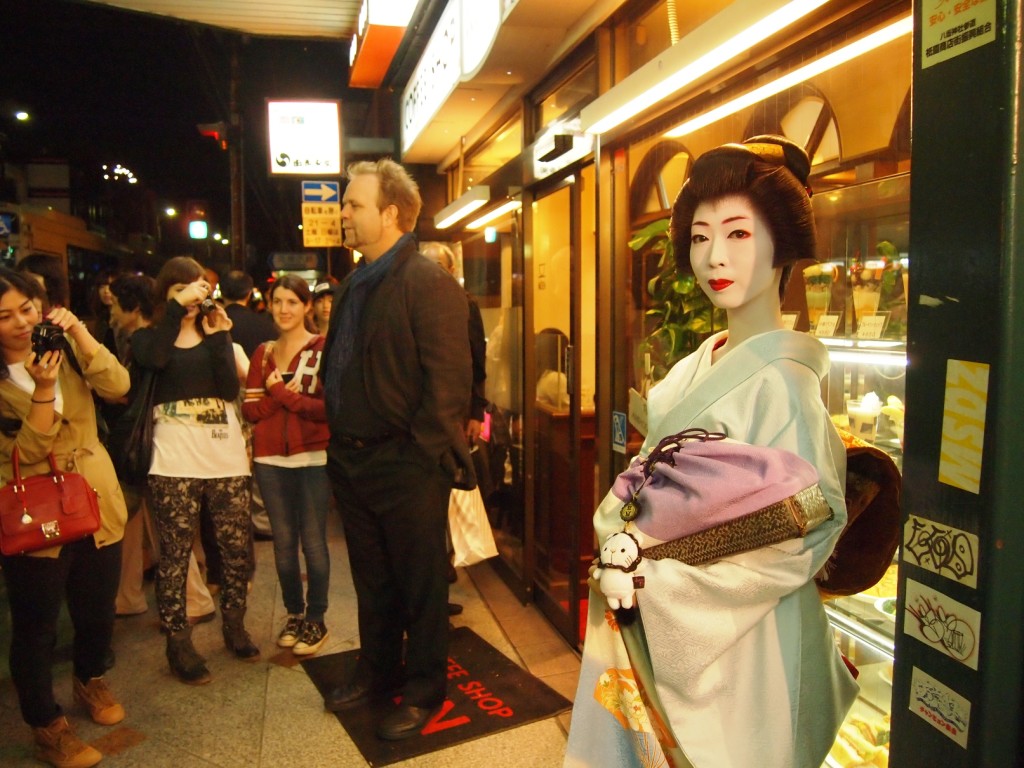Koharu is 17 but doesn’t go to school, have a cell phone or any social media accounts. She only communicates with her family via handwritten mail and sees them just once or twice a year.
Her days in Kyoto, Japan are taken up with lessons in the nearly lost arts of flower arranging, tea ceremony, traditional dance, games, musical instruments, calligraphy, painting and perhaps most important, the art of conversation.
After lessons, several evenings a week, she is expected to entertain at as many as four exclusive parties, one after the other. Her kimono is so heavy (more than 40 pounds) and ornate she needs someone to help her dress. Her elaborate coif, she says, can make sleeping tricky as it is meant to last several days. Hair ornaments alone can cost $1500.
Welcome to the traditional and mostly hidden world of the geiko. Westerners are more familiar with the term geisha, but those here, believe that term derogatory and stress that today, unlike before World War II, there is no prostitution involved nor children. Geiko is a commitment to a traditional culture that has been ongoing here, especially in Kyoto, now a city of 1.4 million, for hundreds of years. The culture remains the strongest in this city.
The money Koharu earns entertaining—and it can be considerable– goes to her housemother—for five years. And she thinks that’s totally fine. By the time she has finished training, her housemother will have invested as much as $500,000 in Koharu, which is expected to be paid back.
Koharu, who I met in Kyoto through a unique program offered by the WaRaiDo Guide Networks, is called a maiko, two years into her training to become a full-fledged geiko. Under Japanese law, girls today must complete junior high school before leaving for maiko training. “My parents weren’t happy at first but now they are,” Koharu said.
No one knows exactly how many geiko there are in Japan though clearly there are fewer than when this culture was at its height in the 19th century and early years of the 20th century when there were as many as 2,000. In Kyoto today there are about 67 maiko and 177 geiko, according to the city tourism officials who promote the five districts called Kagai where these women live and work–some into their 80s.
Their numbers appear to be increasing, likely because some have become celebrated entertainers featured on television and in ads. Young teens in Japan may have seen them on school trips to Kyoto and become intrigued with the culture, suggests Ted Uneo, an expert on the subject and managing director of WaRaiDo Guide Networks. Once girls graduate to full geiko status and have paid back an agreed upon sum to their housemother, they can earn high salaries, he said. And they are respected for their accomplishments.
We toured the back streets of the famous Gion district, the center of the geikoculture, with WaRaiDo’s popular and unique evening tour that draws 400 guests a month, catching a glimpse of these women in full costume and white make up, clop-clopping along in high-heeled wooden sandals.
Our guide pointed out a house where they live on one street, a traditional teahouse where they perform, and the theater where they demonstrate their performing arts. Afterward, Ueno arranged for us to meet Koharo at the tiny Shojiro Okuoka, a local restaurant in this district.
Typically, seeing a maiko or geikoperform in a traditional tea house is very expensive—as much as $2000 a person—and so exclusive, Ueno said, that guests must be invited by a regular tea house member—kind of like getting invited to play golf at an exclusive club.
Uneo, who has made it his mission to introduce Westerners to the “behind the scenes ” Kyoto and Japan experiences, arranges a tour in English, traditional multi-course Japanese dinner and the chance to watch a maiko perform starting at roughly $150, if you have at least seven in your group, more for a smaller group.
Still, why would a teen opt for this regimented and some would argue archaic way of life? “I like kimonos,” Koharu tells us. I take that to mean she likes traditional Japanese culture and arts.
Mondays are her only day off—every other week. “It is a very hard business but for me it is OK,” she said, adding she wishes Westerners had a better appreciation for her art.
There was a noisy group of Japanese businessmen at the table next to ours but once they realized we had engaged a maiko, they quieted down and soon left. “It is rude to talk to geiko or maiko arranged by other guests,” Ted Uneo explained. Lesson for foreigners: it is also a faux pas to take a picture of a geiko or maikoengaged by someone else.
The tradition began centuries ago when people came to Kyoto to visit the city’s famous Shinto Shrines and Buddhist temples. Afterward, they would visit teahouses and drink sake. The teahouses began to employ young women to entertain the visitors. In those days, some female children were virtually “sold” into the life by their poor parents.
Today, there is a geiko Association in Japan you can contact for an interview. If you have the right “look”–you must be petite and pretty—and attitude, your training can begin.
Does Koharu wish for marriage and children? “It would be very sad to leave this life,” she said.
“Today, Japan is not so prosperous,” observed Uneo. “Some girls have rethought their opportunities.”
